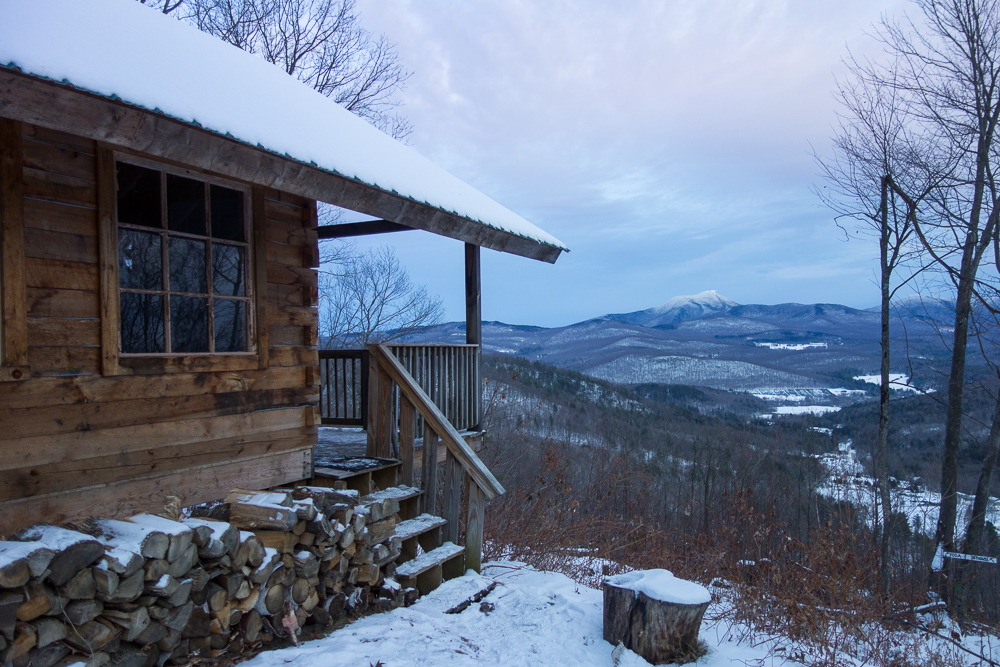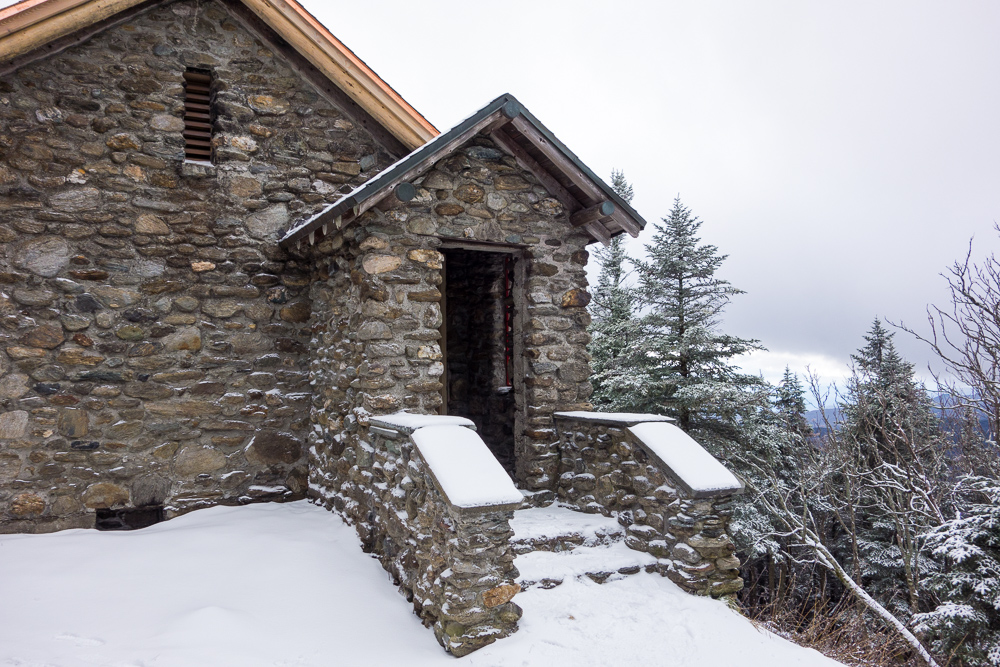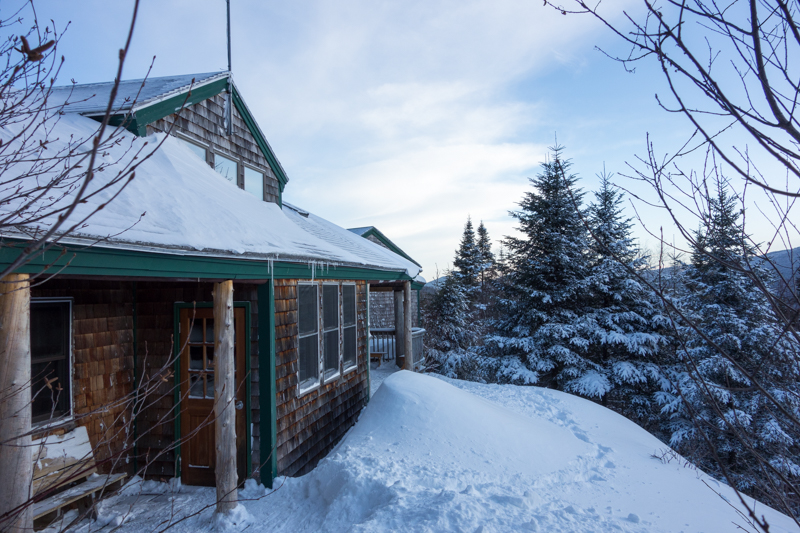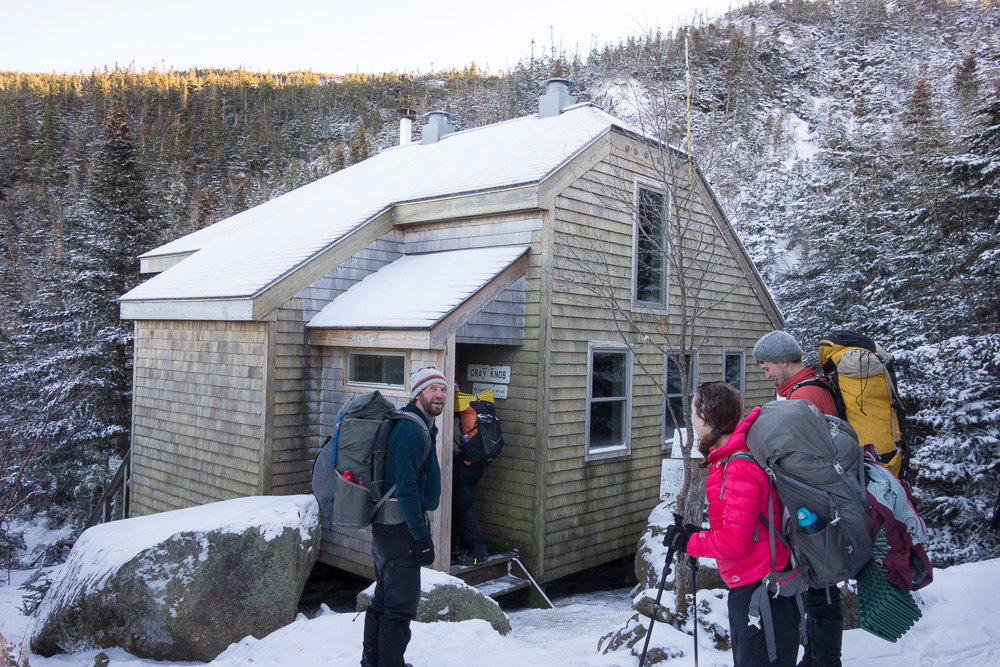I am not a winter camper, at least not in New England. Winter camping in NJ, maybe. Winter camping in Vermont, no, thank you. The nights are too long, the temperatures are too cold, and moisture management makes it very difficult to stay warm. But I do love to have a destination when hiking or skiing, especially an overnight destination. Enter: primitive cabins. More than a lean-to, I’m talking four walls and a wood stove. It doesn’t have to have electricity or even water, but it needs to block the weather and have fire, and preferably a stock of dry firewood. Otherwise, I still like to carry most of my gear in. That is my winter camping.
Ever since I started going to cabins like this in the winter, I’ve been on the lookout for more. I’ve made it to a fair amount of them, but I share with you now my list of places that I’ve both been to and still need to get to. These cabins are right on hiking or ski trails, which means there is plenty of hiking or skiing to do even after you arrive.
Vermont
Green Mountain Club Camps
GMC currently has three rental cabins: Byrant Camp and Bolton Lodge in Bolton Valley, and Hadsel-Mares Cabin on Wheeler Pond in Barton in the Northeast Kingdom. (A second camp on Wheeler Pond will be rebuilt eventually.) They each sleep eight, have a privy outside, a wood stove inside, and a stock of dry firewood. They are very reasonably priced, plus GMC members get 20% off!

Bryant Camp
Bryant and Bolton are on the Nordic and backcountry ski trails of Bolton Valley Resort so you do need a day pass for each day of your stay there. I’ve stayed at Bryant once and Bolton twice, and I prefer Bolton of the two. That may be because it’s on a trail I can actually ski, unlike Bryant. Most people (who I assume are good at skiing) prefer Bryant. I like Bolton’s inside layout better too though, with bunks instead of a sleeping loft, and plenty of space to spread out. Bolton Lodge is either a .6 or 1.5-mile ski or snowshoe in, depending on where you park. Bryant is a 1-mile ski or snowshoe uphill from the Nordic center. Either way, you’re right on a network of miles and miles of ski trails to continue your adventures. Reservations open in May for the entire next season, and winter fills up fast.

Bolton Lodge
Hadsel-Mares Cabin is actually my favorite of the three and I’ve stayed there three years in a row. It’s more like car camping since you can drive almost to the door, but it still makes this list because you can walk out that door and start hiking in several directions. I also like its proximity to the ski trails in Willoughby State Forest, just a 20-minute drive away.

Hadsel-Mares Cabin
Merck Forest & Farmland Center
Merck Forest & Farmland Center in Rupert has many different cabins to stay in, sleeping two to twelve people each, at anywhere from .5 to 2.25 miles away from where you park. I’ve only been there once, sleeping in one of their lean-tos during mud season, but we hiked around quite a bit, checking out all the cabins we passed. They all have privies and wood stoves, and dry firewood is present, but costs extra. I think I’m capable enough to ski to a number of these cabins and I hope to get a reservation for one next winter.

Viewpoint Cabin
Butternut Cabin
On the trails of Sleepy Hollow Inn Ski & Bike Center in Huntington, Butternut Cabin does require day passes for all the days you are staying. It sleeps eight, including camp mattresses, has a wood stove and dry firewood included, and has an outstanding view of Camel’s Hump (even from the privy). I stayed there this winter and would love to go again. There wasn’t enough snow to ski while I was there so I can’t comment on the difficulty of the trails to get to the cabin, but it is only a 1-mile ski or 1.5-mile snowshoe in. The only weird part is that it’s open to other trail users during the day, so if you rent for multiple nights in a row, you’re supposed to just push all your things to the side so other people can come in. I wouldn’t feel comfortable leaving all my gear there while I’m out skiing, so I’d probably only stay one night at a time.

Butternut Cabin
Vermont Huts Association
The Vermont Huts Association has a network of backcountry huts to choose from. Most of them are maintained by other organizations and are just listed there, but they do have some of their own huts to rent as well as managing rentals for some private owners, including Chittenden Brook Hut in Chittenden (sleeping ten), Triple Creek Cabin in Huntington (sleeping four), Nulhegan Confluence Hut in Bloomfield (sleeping six), and Crow’s Nest Yurt in Huntington (sleeping six), which just came online last week! I actually skied by that one at Camel’s Hump Nordic and it looked really cozy. I have not stayed in any of the huts they manage, but from what I understand, they all have wood stoves, firewood, bunks, and privies, and some also have mattresses and propane cooking stoves and accessories.

Crow’s Nest Yurt
Mount Mansfield Stone Hut
Rented out by Vermont State Parks in the winter only, the Stone Hut on Mount Mansfield is right on the trails of Stowe Mountain Resort in Stowe. You can ski or snowshoe up or take the lift up, but note there is no lift service down. (Also note that if you take the lift, you can only bring a bag that fits on your lap.) It sleeps twelve on bunks, has a wood stove for heat, and firewood is included. Bathrooms and water are in a nearby ski patrol building. There’s a lottery to book this one and it’s booked solid every winter. I checked it out one November on a walk up the toll road, which is a ski trail in winter.

Stone Hut
Long Trail Shelters with Wood Stoves
There used to be more Long Trail shelters with wood stoves, but they had a habit of burning down, so now there are very few stoves left. Remaining shelters with wood stoves include Spruce Peak Shelter near Manchester Center (sleeping 16; 2.8 miles in at the shortest distance) and Beaver Meadow Lodge near Morristown (sleeping 15; 2.9 miles in at the shortest distance). Governor Clement Shelter near North Shrewsbury has a fireplace, but it’s a three-sided shelter, so not what I’m looking for. Long Trail shelters are free, first-come, first-served, and do not come with any firewood. Since finding appropriate dry wood in winter seems next to impossible, I would bring wood in on a pulk if I planned to stay at any of these. It’s also useful to know that following the Long Trail in winter is quite difficult as the trail is not maintained for winter use.
New Hampshire
Appalachian Mountain Club Huts
In the White Mountain National Forest, some AMC huts are open for self-service in the winter: Zealand Falls Hut near Jefferson (6.2 miles in), Carter Notch Hut near Gorham (3.8 miles in at the shortest distance), and Lonesome Lake Hut near Lincoln (1.8 miles in). During the summer, you pay an exorbitant amount to sleep in a large bunkroom and get all your meals cooked for you. In the winter, it’s a much more reasonable price to get a bunk with mattress and pillow, self-service kitchen access, and a caretaker that gets the wood stove going after 4pm, just enough to keep the main room warm-ish. That means the bunk rooms are not heated, but a good winter sleeping bag and a hot water bottle work well. I stayed at Zealand Falls Hut in the winter once and I prepared to be a little too cold, which meant I woke up sweating and had to get rid of some layers. The more people staying there with you, the warmer it gets (relatively). Unlike most of the other places on this list, space is rented out per bunk, not the hut as a whole.

Zealand Falls Hut
Cold River Camp
Also maintained by AMC, Cold River Camp in Chatham has one building open to winter rentals. “The Convent” has six bunks with wool blankets and pillows, electricity (!), a kitchen and accessories, a wood stove and firewood, an external privy, but no water. It is just .1 mile in from the road, so maybe not quite backcountry, but still a good base camp for winter hiking.
High Cabin at Cardigan Lodge
AMC’s High Cabin at Cardigan Lodge in Alexandria is 2 miles up, has twelve bunks with mattresses, a composting toilet, a propane stove with propane, and a wood stove with firewood. At only a half-mile from Mount Cardigan’s summit, it looks like a great place to stay and enjoy the hiking and ski trails.

Mount Cardigan
Randolph Mountain Club Shelters
RMC maintains some shelters in the Whites too (near Randolph), one of which has a wood stove. Gray Knob is 3.3 miles up the trail on the side of Mount Adams, sleeps 15 in the loft, has a small fee, and is first-come, first-served. A caretaker keeps a fire going in the wood stove in the evening to keep the temperature generally above freezing and also to control condensation. I had a lot of fun on my one stay there. (Their Crag Camp is also enclosed but has no wood stove.)

Gray Knob Cabin
White Mountain National Forest Cabins
The White Mountain National Forest‘s Doublehead Cabin is 1.8 miles in, just about on the summit of North Doublehead Mountain near Jackson. Black Mountain Cabin is 1.4 miles in, just below the summit of Black Mountain near Jackson. They each sleep eight, have a wood stove, and a privy outside. There is no firewood included so you need to bring your own. (Although drive-up, their Radeke Cabin on the Kancamagus Highway near Albany is in a great base camp location for exploring trails. Sleeping ten, this cabin does include firewood.)
Dartmouth Outing Club Cabins
The Dartmouth Outing Club has nine cabins available to the public in the Whites, sleeping anywhere from 6 to 49 people, at a distance of up to .75 mile from parking. They all have privies and woodstoves (except one has a propane heater instead of a wood stove), but some also have propane cook stoves, gas lights, or even electric lights. They can only be reserved four weeks in advance so you can’t plan ahead too much here. DOC has even more cabins available exclusively to students, alums, and employees.
Harvard Cabin
The Harvard Mountaineering Club has a cabin 2 miles up the eastern side of Mount Washington that is available to the public. It sleeps 16, has a small fee, and is first-come, first-served. Stop by the Pinkham Notch Visitor Center to sign up for your spot on the way in. A caretaker keeps a fire going in the wood stove from 4-9pm but otherwise there isn’t any heat. Large groups (6+) are encouraged to camp outside so try to keep to small groups only if you want some of that wood stove goodness.
Maine
Appalachian Mountain Club’s Maine Wilderness Lodges
AMC has three wilderness lodges in the 100 Mile Wilderness in Maine: Gorman Chairback, Little Lyford, and Medawisla. I’ve been to the 100 Mile Wilderness on my Appalachian Trail thru hike, but I have not yet been to the lodges, or been to the area in winter. Lodge-to-lodge skiing is very popular, and AMC will even shuttle your gear between huts via snowmobile. Shared bunkhouses and private cabins are available at each of the lodges and your stay also comes with three prepared meals and hot showers! Some of the lodges even have saunas! This is a little cushier than I generally look for, but I would give it a try just based on the large trail network of 90+ miles available to explore. West Branch Pond Camps and Moose Point Cabin are separate, privately owned rental camps that are on the same trail network so you could string all kinds of stays together. A friend did a 6-day trip here recently and loved it.
Maine Huts & Trails
Maine Huts & Trails has an 80+ mile trail network and four huts you can ski between: Stratton Brook Hut, Flagstaff Hut, Grand Falls Hut, and Poplar Hut. There are shared or private bunkrooms at each, and they also have hot showers included. Volunteer caretakers keep the heat going and you are welcome to use the kitchen. This is another slightly cushier option, but worth it for the vast trail network.
Baxter State Park
Back to the less cushy options, Baxter State Park near Millinocket is definitely rugged at any time of year, but especially so in the winter. There are bunkhouses with wood stoves and firewood at Chimney Pond (sleeping 10), Roaring Brook (sleeping 10), Russell Pond (sleeping 8), South Branch Pond (sleeping 8), Trout Brook Farm (sleeping 4), Togue Pond (sleeping 4), and Nesowadnehunk Field (sleeping 4). There are cabins with wood stoves and firewood at Daicey Pond (4 cabins sleeping 16 total) and Kidney Pond (4 cabins sleeping 16 total). The cabins include mattresses but the bunkhouses do not, and they all have propane lights. The park has an extensive winter handbook and you have to make reservations in person or by mail at least a week before your trip. Your reservation form has to detail any previous winter experience in Baxter or other wilderness areas. They’re not messing around. I love Baxter State Park but it is an awfully far drive out there, and before I knew about these heated options, it seemed too intimidating for a winter trip. Now, I hope to get there someday.

Looking down on Chimney Pond (Now imagine this in winter)
New York
Adirondack Mountain Club Lodges and Camps
ADK has multiple heated winter options for hikers and skiers. Johns Brook Lodge near Keene Valley is 3.5 miles in, sleeps 28 in shared bunkrooms with mattresses, has a caretaker to handle the heat via a wood stove and propane heater, and allows guests access to the kitchen. Johns Brook Camps consist of Grace Camp (sleeping 6) and Camp Peggy O’Brien (sleeping 12), both of which have mattresses, propane cook stoves and kitchen accessories, propane heaters and lights, and outside privies. They are also about 3.5 miles in and are booked as a whole, not per bunk like the Lodge. I first learned about the camps during a hike along Johns Brook when we ran into a few guys with pulks loaded up with meats, beers, and climbing, skiing, and hiking equipment. It looked awesome. (ADK’s drive-up options include Adirdonak Loj at Heart Lake and a few Heart Lake Cabins near Lake Placid. They’re cushier than the Johns Brook options for sure, but they do still have out-the-door trail access.)

Johns Brook
Adirondack Hamlets to Huts
Adirondack Hamlets to Huts is a new initiative that hopes to connect lodging in local communities with trails. I look forward to seeing what they come up with for skiing and snowshoeing routes.
Catskills
I have yet to find any similar cabins in the Catskills, but please let me know if you know of some!
Miscellaneous
I’ve noticed that a lot of cross country ski resorts have places you can rent right on or near the trails, although they don’t tend to be primitive cabins. Some warming huts at ski resorts also allow people to sleep over. Not to mention the private cabin rentals on Airbnb, Hipcamp, etc. Of course, the best place to stay might be your or a friend’s private cabin, but we can’t be that lucky all the time.
Where is your favorite (heated) place to stay in the backcountry in winter? What am I missing on this list?


What a great roundup!! I sure wish I had checked out some of these when we lived in NH, but we had just started XC skiing & snowshoeing, so day trips were our max.
Hello! Your post is very interesting. If you want to expand your list, there are also many backcountry huts in Quebec, that are accessible only by snowshoe or nordic ski trails. Provided the US-Canada border will reopen some day. I am currently updating an Excel register of huts, and so far it contains more than 200 huts! I have been organizing weekend trips in such huts for family or a group of friends, over the last 35 years. My criteria are that it must have four walls and a source of heat such as a wood stove, and not be accessible by car. Ideally, I like to choose huts that give access to a good network of trails. Some huts I liked in the past fell in disrepair and were closed or destroyed, but there are news ones that were built elsewhere, so overall I would say there was a net gain over 35 years.
I’d be curious to learn of the Quebec huts!